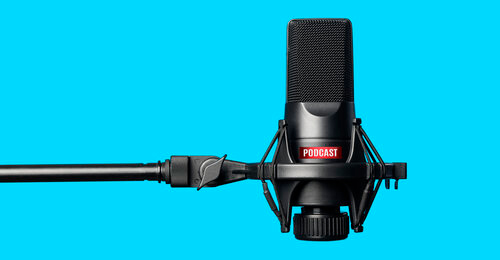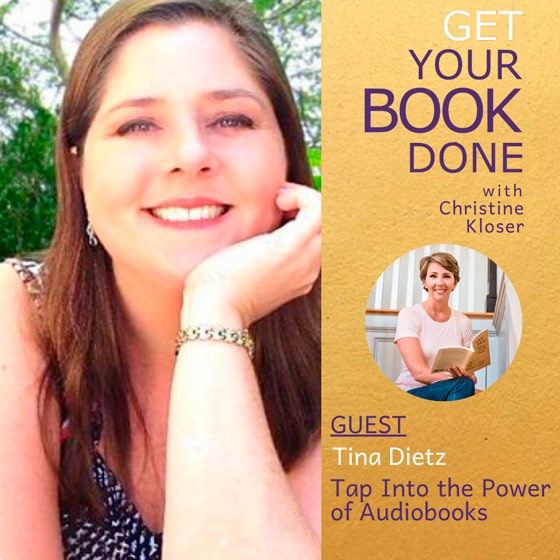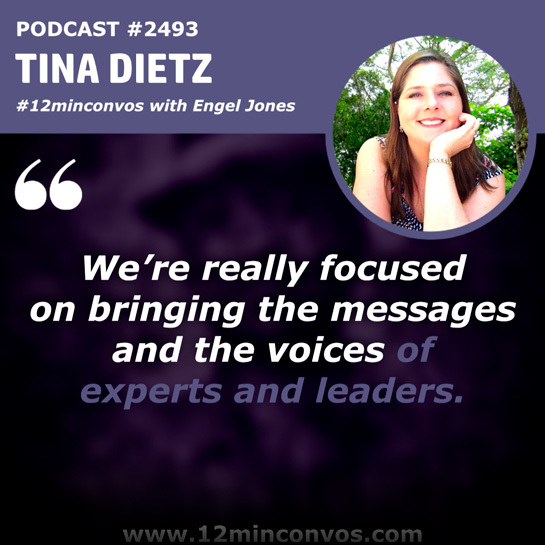Vocal Leadership: Turning Your Voice Into a Weapon for Good with Tina Dietz [Podcast]
Tina Dietz joins Paul Higgins to share how you can refine their vocal leadership and turn your voice into a weapon for good. Tune in!(Podcast on Build Live Give, May, 2020)
Aside from entertainment, part of the value of being a coach or a public speaker is the education and the inspiration that you provide. For Tina Dietz, going deep into the world of audio was her way of being of service to other people and the path to having a scalable company. Tina is an award-winning and internationally acclaimed speaker, audiobook publisher, podcast producer, and influence and vocal leadership expert. Her company, Twin Flames Studios, amplifies the influence of leaders, experts, and companies around the globe. Today, she joins Paul Higgins to share how one can refine their vocal leadership and turn their voice into a weapon for good. If you’re into voice acting, public speaking, or anything that involves talking, tune in to this episode and be inspired to get your voice and message out to the people who need to hear them.
Listen to the podcast here:
Vocal Leadership: Turning Your Voice Into a Weapon for Good with Tina Dietz
Build Live Give. Mentoring With Paul Higgins
Our guest is someone who worked in social enterprise and loved teaching, which led to improving the lives of others. She then started to work in their family business because they knew that they couldn’t continue to work for others. As a hobby in the background, she was a paid voice actor and having deep entrepreneurial roots, particularly from her parents, she looked on how to monetize it. She has been helping leaders share their wisdom through voice ever since. You will experience firsthand how to do an on-air ad. I love this episode and I hope you do as well. Get three tips to improving your podcast, where the podcasting industry is headed and how you can benefit and also how LinkedIn has become a virtual conference and the way that you can participate in it. I’ll hand you over to Tina Dietz from Twin Flames Studios.
_
Welcome, Tina Dietz, to the show. It’s great to have you on.
Thanks for having me, Paul.
I’ve been looking forward to this interview for a long time given your experience. Why don’t we start with something that your family or friends would know about you that we may not?
If you get to know me and you end up coming over to my house, I love having people over for dinner. I’ve often had people say that I’m an Italian grandmother in training, which I take as a great compliment. I often, to unwind, we’ll do what I call kitchen karaoke, which is turning on karaoke while I’m cooking in the kitchen and encouraging other people to join along. These are full performance karaoke because it’s much more important to be as free and as ridiculous as possible. I find this incredibly therapeutic, so I’m bursting into song at a moment’s notice—it's something you have to watch out for if we want to be friends.
Does this include dress ups? Do you take it that far?
Yes, in an ideal world.
What are you doing to supplement this fantastic gift that you have? Because in Australia, we can’t have people over for dinner.
I’m not doing “instead of”—it’s more of an “also and”—my kids know that they either need to enjoy it, join in, or leave. Those are your three choices in this scenario. It depends on their mood. My husband, it's the same thing. He fortunately will join in. Sometimes I do have friends and colleagues, occasionally family members join me over video for ridiculousness. We’ve been known to show up in weird costumes or makeup or things like that. My beloved husband has allowed me—his facial hair grows quickly, but he’s usually clean-shaven—and I’ve even talked him into growing out his facial hair for a week or two so that I can do ridiculous things with it and give him different looks. He’s been tolerant.
I know you started—I’ll summarize it by “social enterprises”—working for them for quite some time. In 2014, you launched Twin Flames Studios. Take us a little bit through the transition of working for others to now running your own business.
I stepped off into working for myself several iterations before Twin Flame Studios. I was a therapist by training, but grew up as an entrepreneur and spent a number of years trying to work with other people, not having a good time dealing with bureaucracy. I started a family business with my dad. People always say to me, “When you were business coaching years ago, why didn’t you specialize in the family business?” I said, “Because I would like to remain sane and unmedicated.” A family business is a particular animal and I grew up in a family business—I love my father and I definitely would not do that again. Where I learned online business—where I cut my teeth on that—was with a company called the Nayada Institute of Massage. She’s a very gifted massage therapist. I started my business coaching and consulting. I worked on that for many years and then took a turn when I wanted to scale my company into audiobooks and podcasting because of my deep and abiding love of microphones.
When I read through your LinkedIn profile—and we know each other through a group we’re both in—it did seem like a bit of a leap out of nowhere. Fill that little leap in for us.
It’s not just the karaoke. I’ve been in favor of anything involving a microphone since I was small. Part of what I loved about being a coach, being out as a public speaker and everything was being on stage. The entertainment value, as well as the education and the inspiration that goes along with that. I had been taking voice acting lessons and ended up picking up an agent and having a paid hobby in voice acting on the side. I took some masterclasses in audiobook narration. Because being an entrepreneur, I can’t just have a hobby, I have to have a hobby you can monetize! I had a light bulb go off in that moment as I was finishing up that series of courses, “Why aren’t all my colleagues and clients who are doing books and bestseller launches doing audiobooks?”
That set off what Michael Gerber from The E-Myth would call an “entrepreneurial seizure,” and I couldn’t let it go. I couldn’t put it down. It was one of those things. I got excited, and it still took me several years to come back around to allowing myself to create this new branch of a company because it did seem like such a disconnect. I even had business coaches tell me, “Why do you want to do ‘done for you' services that are going to damage your reputation as a subject matter expert?” I was like, “Why can’t I have it all? Why can’t I have both?” It was when I allowed myself to go into the niche, and allow myself to go deep into this world of audio and being of service to other people and having a scalable company that everything took a major turn for me, both as an expert, and in terms of the financial success of the company.
I’ve got many questions I could ask, but one of them is, you seem like a natural speaker and I find that a lot of people from the US are eloquent. It seems natural for them, whereas a lot of people in other countries don’t find that. Certainly for me, when I first started doing my show, I couldn’t stand the sound of my own voice. Give people some tips on how you get over not being able to stand listening to your own voice.
When I speak—and I’ll ask quite often the question, “How many of you don’t like the sound of your own voice?”—in a room of executives and whatnot, almost everybody in the room will raise their hand. Even in rooms of podcasters or public speakers, I get more than half the room. It’s a human thing because of the resonance of our skull structure. We sound foreign to ourselves, when you hear yourself on tape. It’s displacing and disorienting. It feels like you’re listening to an alien. When people don’t like the sound of their own voice, most of the time it’s because you have this incongruency and the brain hates incongruency.
To fix that, truly what it is—it’s repetition. You have to get used to it. Sometimes I’ll have people listen back to the sound of their own voice and say nice things back to themselves about what they like about their voice. Another good way to do it is to record something where you are saying something nice to yourself. Having somebody read off a whole series of affirmations, for example: “I am worthy. Every day I’m getting better,” and so on and so forth. Give them a list, have them read a recording of that, and then play back that recording because then you’re talking to yourself in a positive way. You’re creating a new voice in your head that likes you. You start to associate the sound of your voice with positive things and that’s helpful all the way around. In this particular case, the only way out is through liking your own voice, because that’s completely a subjective judgment. I guarantee you, nobody out there has ever hung up on anybody who’s listening to this show because, “I can’t stand the sound of your voice. I’m not talking to you.”
I cheat a little bit because if I do listen to myself, I listen at 2½, 3 times speed for most things. I build it up over time. It must’ve sounded a lot better at two times. If you’re currently listening at one, just dial it up a bit. Let’s be fair. That’s for the solo shows. Tina sounds much better at one time.
So, hobbies and monetizing them. There are a lot of people that are going through very unprecedented times and some of them may be thinking this might be the big time to take a leap, “I’m going to leave my job and I’m going to go create.” Any tips on how you start to monetize that hobby?
I have a little bit of two minds about this because I truly don’t believe that the whole ‘follow your passion and the money will follow’ is true. There’s a little more thinking to it than that because there are certain things that we do that we love that if we had to make a living from them, it might kill the creativity. That’s one of the things you have to consider. When I was coming up with this whole idea around the audiobooks, the podcasting, everything, I had to step back and consider, “Where does this come from? Why is this important? Why do I want to do this?” Is it the burning passion that I want to do for the rest of my life? No, but it’s a medium that I can make a contribution in.
I can help people get their voices out to the people who need to hear them. That for me, from a values perspective, is important. It’s more important to look at—what are your values? What are you creating? How is it going to fulfill those values? It’s the first thing to look at. The second thing is you have to be able to consider the ramifications of stepping off. I’ve helped many people through this transition, back when I was business coaching. There comes a point where the pain of staying and doing something you don’t love is greater than the pain of dealing with the financial impact. It’s very much an existential thing.
At the same time, if you can have a backup, if you can have a bridge, if you can have savings, if you can have something there and create a plan—or at least have some proof that what you’re stepping off into is possible for you to monetize—before you leave a comfortable job. Side hustles are great. Side hustles are important, but I don’t recommend that anybody step off into their side hustle as a job and into a whole enterprise until they’ve proven to themselves that they can make at least $1,000 a month from that enterprise. There needs to be some proof that you’ve got some “engine” going.
I wish I had heard that Tina back in 2011 because I did the complete opposite. One day a director at Coca-Cola the next day, who am I? I walked into a room and like, “I don’t know what I’m doing, let alone explain it to somebody else.” That’s great advice. Speaking of advice and supporters. You talked about your dad and working with your dad. You eloquently didn’t end all of that sentence, if your dad’s reading this—but who else supported you through this journey?
Because I have entrepreneurial parents, they were supportive of this particular journey. My kids’ dad, who I was married to at the time, through this whole beginning process of starting a business and going through different iterations of the business. I had a lot of side hustles before I decided to step off into my own thing full-time. I didn’t take all my own advice, but I did have clients and I did have a proven framework. I had a tremendous amount of failure, also, in different things. I was able to keep going. He was supportive in all the ways that he knew how to be. We had young children at the time and everything and he’s a great dad. I’m forever grateful for that support. Then the people who didn’t understand, who aren’t entrepreneurs and they didn’t quite get what was going on—at least they weren’t cruel or dismissive. I’ve had people come back to me over the years and go, “I got it.” I’m grateful for that as well.
I find for any of my friends, unfortunately in Australia often, they receive a redundancy. The next call is normally for me: “How do you make money by being in your track pants at home?” I know exactly what you’re saying with that transition. The next section is the “Build” section. We’ve already talked about audiobooks and your love of kitchen karaoke. When someone says to you, “Tina, what do you do?” how do you best answer that?
I say that we amplify the voices of leaders, entrepreneurs and trusted brands all over the world and our mediums are for doing that. Our podcasts and audiobooks are working with people to refine their vocal leadership so that they can make the impact that they want to make and reach the people that they need to reach. It’s all about having people get what they need so that they can grow. Audiobooks and podcasts are some of the lowest hanging fruit for people to change their lives.
Why are people reluctant to launch a podcast?
Podcasting is a lot of work. I usually recommend that if you are not familiar with podcasts as a medium and you haven’t been a guest on at least a couple, to get a lay of the land, then please don’t start a podcast from scratch. I’m specifically talking about podcasting for business. There are two kinds of podcasting, podcasting as a business and podcasting for your business. This wonderful, fabulous show that you have, Paul, is for your business. It’s part of your brand and your platform. It’s how you reach your audience. It’s wonderful to network with other professionals and it creates this home for you to welcome people and to have these conversations. Podcasting as a business is when somebody starts a show specifically to monetize it.
It’s usually sponsor-based and things like that. Those podcasts tend to be your true-crime podcast, your specialty podcasts like the Horse Radio Network or the show Trivial Warfare, which is pub trivia, but in a podcast format. Fantastic shows, those are high entertainment value and designed to be businesses in and of themselves. These are all things that you have to think about beforehand. Strategy planning and how much time you want to put into it. It’s super important before you decide to go ahead and launch a show.
You’ve seen an enormous change in the years you’ve been running Twin Flames. What do you see in the next 5 to 6 years? Where do you see podcasting of both types going?
Seth Godin has been saying that podcasting is the new blogging. I think that much like how blogging evolved over the years, we’re going to see a lot of people in the next few years flock to podcasting as a personal project. Not every podcast has to be monetized. It can be a passion project. It can be something you love to do. I never want to kill anybody’s dream of doing that because I understand the love of the microphone and connecting with people. I’m the first person to say that. At the same time, I think we’re going to see a lot more corporate influence in podcasting. This is not necessarily a bad thing because it does bring more dollars to the table and it brings more credibility to the medium. We've seen more large companies jump into podcasting, not even for external podcasting, but for internal podcasting. Using podcasting for internal communications, for making sure that in a workforce that maybe is working from home or on the road, you can keep culture strong and have communications be out there, celebrate each other’s wins, and all of that good stuff.
That’s another trend that we’re going to continue to see more and more of. I think we’re also going to see more businesses seeing the value in podcasting as an advertising medium and jumping in and doing long-form, narrative podcasting—the kind of podcast you’d hear on maybe National Public Radio in the US. It’s storytelling-based, but for business. There are companies like Pacific Content who are already doing this with companies like Facebook, Charles Schwab, and all that. That’s also going to continue as well. It’s an exciting and evolving world. I’m thrilled to be part of it.
Coming from a marketing background, you had to measure everything. It’s hard to measure things in marketing, but particularly in podcasts, it’s been difficult to measure things. How do you see the measurement supporting more dollars coming into the advertising spend?
Where we’re seeing the research coming out is in things like sticky branding. The listeners of podcasts reporting to survey companies like Edison Research who go out and do a lot of podcast research. They’re reporting that people are 80% more likely to purchase a brand that they’ve heard on a podcast that a host has endorsed—host-read ads, it’s really important that the ads are endorsed by the host or they’re tested by the host, there’s a relationship with the host. That’s the magic of advertising or sponsorship through podcasting.
I know this audio-only medium is intimate. Back when I was the lead interviewer on the podcast documentary, The Messengers, I interviewed 40 or 50 different podcasters. Almost none of them knew each other and the word intimacy kept coming up. Every single person mentioned it, that their communities had this bond and this intimacy over these topics. Maybe it was business or maybe it was about being part of a certain group. Maybe it was being part of a community that was part of fandom around a television show, and the things that would happen for people to support each other even though they had never met. There’s so much available here for us to explore. Storytelling is universal, and that’s important.
Going back to the numbers—this is why I think we’re going to see a lot more around internal podcasting. It’s easy to track the numbers around internal podcasting in terms of engagement. Engagement is a huge issue worldwide in the marketplace, for companies to increase engagement. We hear this over and over again in human resources and executive circles: “We have to increase engagement. We have to retain our talent. We need to increase efficacy,” all those things. There are specific measures and numbers that we can draw on that—it's little harder for external podcasting, but I’m hoping that we’ll see some breakthroughs in that area as well.
You hear numbers: There are 700,000 podcasts. There are lots of podcasts. I often talk to coaches and consultants and they say, “I don’t think the world needs another podcast.” What do you sayin when you hear that from potential clients?
I think that’s entirely possible. There’s a whole world of podcast guesting that is just as valuable in many cases as having your own podcast. I work a lot with executives and CEOs on their podcast messaging and the vocal leadership work that I do to have them be able to understand how to be interviewed on a podcast and what kind of content there is. The storytelling, and how you create a relationship with someone without seeing their face and interacting live—all of those things, that’s part of the world we’re in. It’s okay if you don’t want to start your own podcast. Maybe that’s not your entry point, but considering podcasting in all of its formats, internal podcasting, external podcasting, podcast guesting, or maybe your brand even advertises on podcasts as a sponsor, that’s another option too.
It’s a medium that’s not going away. How can we use it for our companies, businesses and our brands to utilize it the best way for you? I know that I’m engaging you to organize my podcast, which I’m a little nervous about, especially as having you as a guest. What are some of the key themes that you look for when organizing a podcast? If someone could think of this is what an expert like Tina’s looking at, so I can at least go and address some of those areas of my podcast. What would be those key things?
A couple of the basic things, and this is usually in the setup of your podcast: One, making sure you’re in the right categories. You’re able to get into three categories and subcategories in most cases and making sure that that’s aligned with what you’re doing. The second thing, is your show name—something that people are going to understand when they see it. Is that show name going to attract the people that you want as listeners immediately? This is where we run into that push-pull we sometimes have in our hearts about wanting to reach everyone. Because the truth is podcasts work better when they are niche, and when they reach a deep audience rather than a wide audience. That’s podcasting for your business. Podcasting as a business is a different animal—I keep having to make that distinction. When people see themselves immediately in your title and your content, they’re much more likely to become loyal listeners faster. That’s important.
The other thing is the length of your podcast. The question I get asked the most about podcasting is, “How long should my podcast be?” The true answer to that is however long you can be outrageously interesting for. Because in a solo show, truthfully, most people cannot be super interesting for longer than twenty minutes. It’s hard to do. It’s a lot of material to write because what is interesting to you in your head and what you’re teaching might be valuable content, but is it entertaining? Because entertainment is the most important thing about podcasting. It’s more important than education. It’s more important than inspiration. All of those things are secondary to entertainment. That’s where it comes into play. We say 20 minutes for a solo, 40 minutes for an interview is our general rule of thumb when you’re working with podcasting for business. Could it be longer? Yes, there are certain cases where that may happen, certain industries where people love in-depth content. Those are some of the first things that we start looking at.
For me, I find some of the big commercial podcasts, I find a little frustrating where of that 40 minutes let’s say or most of them are an hour. The ones that I listened to might be ten minutes are the same ads every time. I use the podcast app. I skip the start. I try to skip the end, which I know is just noise, but for you giving advice to people doing that or people like for myself, how long should ads be? Where should they be? Give us a little bit of advice on that.
This is where creativity comes into play. As I mentioned before, host-read ads are far more important, but where can you create storytelling around those ads? Do you have any particular sponsors that you have, Paul, or that you’ve heard of or maybe one you’d like to have?
I have got a sponsor.
What’s the name of your sponsor?
It’s Dubb.
They do some video production hosting. What’s the one thing you love about them?
The ability to break through all of the noise, especially on LinkedIn. A lot of people send texts, that’s all boring. Whereas when I send video on LinkedIn, it gets a lot better response.
Is it Dubb.com?
Yes.
On a host read ad, it might be something like, “I want to give a mention here to a tool I’ve been using lately. Have you heard of Dubb.com? There’s a lot of video production platforms out there, but what I love about Dubb is that I’m getting much higher engagement on LinkedIn. You know I love LinkedIn. I do a lot of networking on LinkedIn, so it’s important for me to have tools I can rely on. I’m encouraging you all to check out Dubb.com and see how you like it. I’d love your feedback. I’d like to know if you’re using it. Tag me in your posts on LinkedIn if you decide to use this tool and let’s compare notes. So check it out at Dubb.com.”
And that's why you have experts on your podcast! That was brilliant! You talked about LinkedIn. I know we’ve been working together for a little bit on LinkedIn. Tell us a little bit about the journey so far on LinkedIn for you.
I’ve got a large social media following around almost 200,000. At the same time, I have been frustrated with social media for a long time. It helps with our SEO. Certainly, it helps with our visibility. At the same time don’t tend to get a lot of business from our social media presence. That is why I reached out to you because we’re turning our attention to LinkedIn. Relationships are what is most important to me. We had a mutual colleague, Harry Duran, who’s also a podcast consultant. He introduced the two of us. In the months that we have been working with the BLG Collective, and you on LinkedIn, it’s fascinating—it’s been night and day. The best way I can put it is, the difference between going to a conference, when I go on to LinkedIn, I feel like I’m walking into a conference.
It’s a giant room full of people. Some of them I know, and some of them I don’t know, but it’s thousands of people in a room. Having the experience of working with this collective is like a little pod or a mastermind inside of LinkedIn. I’ve gotten to know some of these people and their work. We’re helping each other with our networks. I’m finding fantastic referrals, gaining referral partners, meeting people I would never have met before outside of my circles, which is valuable because it’s like walking into a whole new room or a whole new conference. I’m reaching people like crazy. The number of views and who’s commenting and the response that we’re getting is great. I’m super excited about continuing to build on it because I know it’s been a couple of months and I’m scratching the surface of what’s possible.
Before we go into the “Live” section, I do a live ad. What I’m going not to do is read out what I normally would give them, what Tina has given an absolute masterclass from the Dubb. If you do want to find out more about our community, it’s called Build Live Give Authority Machine. It helps you be seen as an expert and it’s important in these times. We’ve all received communication through LinkedIn. Did you read this before you sent it? What we do is help you build those relationships. There’s a great free live masterclass that you can watch. It’s around 30 minutes. As I said, with my voice, I’d speed it up so you can get through it in fifteen. All you have to do is go to BLGClick.com and you can watch that. Also, there are lots of tasks there on LinkedIn that can be done by somebody else. It doesn’t have to be by you. If you haven’t got a virtual assistant and you’d like to know more about that and how we use them to expedite both your authority and also new clients, go to BuildLiveGive.com/VA. The next section is the “Live” section, Tina. What are some daily habits that make you successful?
I do have a daily habit of meditation and exercise. That’s how I start my day. It took me a long time to get into the meditation part of things. I’ve been a pretty loyal exerciser—more on than off—for the last few years. The meditation is something I resisted, which is funny because both my parents are yoga teachers, but I finally surrendered to that. I’m glad I did because it’s important as well as the exercise. I also make sure I laugh at least once a day, whether it’s with my kids or watching something funny. A lot of times it’s with my husband being silly and making each other laugh. I need that connection. Those are probably my top three. I also have a routine of certain supplements I take to support my body, water intake, and things like that. Health and wellness are important to me.
You’re eating at least once a day if not more. If you’re doing that through karaoke in the kitchen, I’m sure you have more than one laugh a day. As I subtly said before, we’d love to see a little video even if it’s a clip that we can share with our audience. That would be great.
We’re going through COVID-19. You’ve talked about it briefly, but what are some of the learnings that you’ve gained through COVID that you will take on out the other end?
I have had this interesting experience because as much as I would have preferred this not happen, it feels as though I have been uniquely prepared to go through this experience. I am unbelievably grateful for that. I feel like I’ve been waiting twenty years to be in the right place at the right time. It’s strange to say that in light of all this, but I have been running a mobile business for more than a dozen years. My children are used to living a mobile lifestyle. They were homeschooled while we lived in Costa Rica some years ago, and they’re old enough to be independent. We haven’t had a tremendous amount of stress load put on us, and what that has allowed us to do is reach out and help more people.
We have gone back out to our former clients and made additional offers of help and support, tele-classes with their teams on vocal leadership, and so on. Not charging for it or anything like that, to help out through this particular process. I have had a tremendous amount of influx of people who are home—a lot of public speakers or companies that are like, “Now is the time. Let’s look at our online presence. Maybe we want to do a podcast. Maybe I want to do that audiobook.” It’s a privilege to be able to help people through that. I can’t complain about being in this situation because if this had to happen, then I couldn’t be in a better place to have to deal with it, to be completely honest. It’s a matter of energy management and making sure that I’m not overworking like crazy because we are trying to help as many people as we can, and working long hours to do so.
Robin, who’s your partner, he’s going to be reading this. What would you like to say to him about the support he’s given you through this journey?
Robin is not just my husband. It’s one of those situations where if people knew how good our relationship was, they wouldn’t believe me. It’s at that point. I know that sounds super Pollyanna and all that, but we’ve worked our butts off to have it be that way. Robin also works in the company with me on the operational side. He’s a 30-year software engineer and data architect. He brings dimensions to the company that to me seem like magic. I’m creative. I’m a visionary. I’m a people person. He’s like, “Why are we doing it this way? Why don’t we automate it? Why don’t we create the system?” It’s beautiful to have that ebb and flow. Support doesn’t even begin to scratch the surface of what he’s provided and who he is in all of this. We don’t get tired of each other. We feel like during the day, even though we’re in the same apartment, we miss each other. We can’t wait to get together at the end of the day because our days are full so that we can hang out after work, have dinner together and chill out.
The next section is the “Give” section. What’s a charity or a community that you’re passionate about, and why?
One of the charities I'm involved with is Project Forgive. It was started by Dr. Shawne Duperon, who’s doing some amazing work. She’s gotten the Dalai Lama involved and many people, Bishop Desmond Tutu, and many leaders from around the world. It’s this global mission to bring the spirit of human forgiveness into our communities and into ourselves as well. She teaches this work called “Accepting the Apology You’ll Never Receive.” If you can think of somebody, something that you would have loved an apology for, but you know you’ll never get it, having the experience of getting that is transformational on a number of levels. They are working with municipalities, with colleges, inside of prison systems, jail systems, and all that to bring this work of forgiveness and bring a lot more compassion to the systems that we live and deal with every day. I couldn’t say enough good things about the work they’re doing in the world.
We’re going to shift gears a little. What we’re going to do is go into the last section, which is the “Action” section. I’m going to ask you some questions and get some rapid-fire responses. The first one is what are your top three personal effectiveness tips?
Make sure you get enough sleep. Make sure you get enough water. And leave time every week to radically do nothing for at least 2 or 3 hours to give your brain a break and a reset.
I’ll do the first two. That last one’s going to be a challenge, but challenge accepted. What tech is essential to running your business?
We run a lot of our company off of G Suite and even the programming that Robin does hooks a lot into Google’s tools. We also love working with Asana for project management. I use Acuity for scheduling. Those are our big things. We stay fairly tech-light on things and run things lean. Those are some of my favorite tools inside the company.
You get the chance to listen to some amazing podcasts and also audiobooks, but what’s your best source of new ideas?
My best source of new ideas is that 2 or 3 hours of doing nothing that I mentioned. It’s that brain reset that allows the frontal lobe to remain juicy. Because if you think about it, you almost never get a good idea at your desk. They always come in the shower, when you’re driving, when you’re on a walk or something like that. That source of new ideas is in the quiet and in the rest, is when that happens.
Doing nothing, that means I can’t even physically move?
No, but it’s more of you’re not reading a book, you’re not listening to a podcast. You can do some manual things. Manual things are part of that but not hard work like swimming—maybe a walk, laying under a tree, that kind of stuff. It’s a challenge. I’m not all that good at it myself but when I do it, it works.
I must admit, for me to change out a corporate to my own business was spent picking all of us for four days with my dad. I don’t think that this experience would have got me to where I am now if I hadn’t done that. That was effectively doing nothing for four days.
The last question is the big one. I always leave it to the end, but what impact do you want to leave on the world?
Years ago when I was thinking about starting a business, I had a coach who said, “Tina, you have to create something that’s big—you can’t do it all by yourself. It might not be something you can finish in a lifetime.” That pissed me off. About a week later, I woke up from a dream where I had this vision of the world where people were all, worldwide, doing what they loved and bringing that sense of doing what they love home to their communities and their families. When they told their kids, “yes, you can do what you love and make a great living,” they were telling the truth from a place of integration and integrity—and that became a default setting for those kids for the next generation for them to pass on. We all have these beliefs. We talk about limiting beliefs, but what if that got turned on its head and our default setting was expansive beliefs? Having these ideas go out into the world through podcasting, audiobooks, and leadership is one of the ways that I want to contribute to creating the world I saw in that vision.
What a brilliant impact you want to leave. You can find out more about Tina at TwinFlamesStudios.com. Also, there’s a bit of a challenge that Tina wants us all to do. Other than do our own recording of kitchen karaoke and share it, she also wants you to search for her name—it’s Tina Dietz—and see how many slots on the first page of Google she covers because she’s telling me there are lots, so let’s put it to the test. Tina, I love working with you within our LinkedIn group. You can find out more about that at BLGClick.com but also, I’m looking forward to helping me spread experts like you spreading their word further with some of the help you’re doing with our show. It’s great having you on. I enjoyed it.
It’s my pleasure, Paul. Thank you.
Stay well, bye bye.
–
I truly enjoyed this one. How good was the ad? It’s absolutely grand. You can find out more about Dubb at BuildLiveGive.com/dubb. What is your biggest takeaway from Tina? Please share on her social media. She would love it. If you believe someone you know would also benefit from the show, please share. You can learn the three secrets to building your authority on LinkedIn in a free, prerecorded master class at BLGClick.com. Please take action to build your business and lifestyle, and most importantly, stay well.
Important Links:
- Twin Flames Studios
- Tina Dietz
- The E-Myth
- Dubb.com
- Authority Machine
- BLGClick.com
- BuildLiveGive.com/VA
- Project Forgive
- G Suite
- Asana
- Acuity
- BuildLiveGive.com/dubb
- Launch Your Audiobook
About Tina Dietz
Tina Dietz is an award-winning and internationally acclaimed speaker, audiobook publisher, podcast producer, influence and vocal leadership expert who has been featured on media outlets including ABC, Inc.com, Huffington Post, and Forbes.
Tina’s podcast, The StartSomething Show, was named by INC magazine as one of the top 35 podcasts for entrepreneurs. Tina’s company, Twin Flames Studios, amplifies the influence of leaders, experts, and companies around the globe.
Connect With Paul and Build Live Give
Thank You for Tuning In!
If you want to find and convert your Ideal Clients on LinkedIn – go to blgclick.com to learn our three steps.
Interested in learning more about Vocal Leadership?













